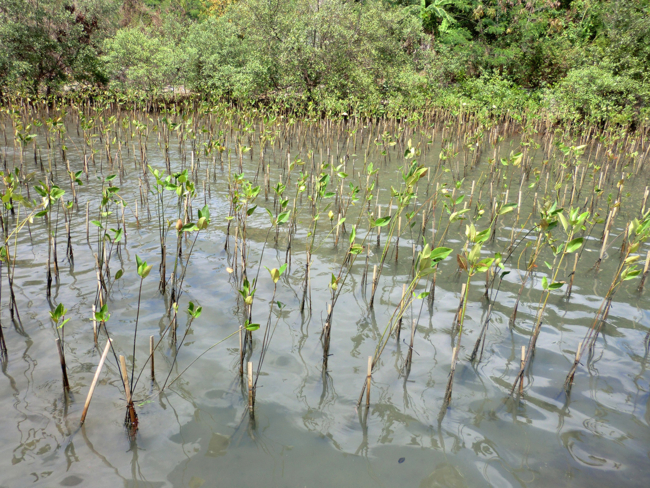19/07/2024 | Planted mangrove forests can sequester 75% of the carbon of intact stands within 20 to 40 years. This is the result of a study involving the Leibniz Centre for Tropical Marine Research (ZMT), which has just been published in the renowned journal Science Advances. The comprehensive analysis by an international team of researchers, led by the US Forest Service (USFS), provides new insights into the potential of mangrove restoration for climate protection.
Mangrove forests are efficient carbon sinks. Through photosynthesis they sequester large amounts of CO2 from the atmosphere and store it as carbon in their wood and sediment. The amount of carbon stored in the biomass and soil of a mangrove ecosystem over long periods of time is known as the carbon stock.
An international team of 24 researchers from 12 countries investigated if planted mangroves can reach the carbon stock of intact stands and how long this takes.
The scientists analysed extensive data sets from four decades, including own measurements and scientific publications. They compared the carbon stock in the above- and below-ground biomass (roots, stems, branches and leaves) and in the sediment of planted mangroves with the values in intact stands and examined global and regional patterns. The team also looked at the significance and influence of different mangrove species.
Mixed-species mangrove forests store more carbon
For the carbon stock in the biomass of planted mangroves the researchers’ results are as follows:
- Initially, the above- and below-ground biomass of planted mangroves grows rapidly and exponentially. After 20 years, they store around 70% of the carbon that intact mangrove forests bind.
- This value remains almost constant for up to 40 years after planting.
- Mangrove forests consisting of mixed-species stands store more carbon than monocultures.
- Planted forests of Rhizophora mangroves are an exception: they sequester even more carbon in their biomass than natural stands after 40 years.
For the amount of carbon stored in the soil (up to 1 meter deep) the study shows:
- At the beginning of planting, the amount of carbon in the soils of planted mangroves is about half that of natural forests.
- After five years, the soils reach about 75% of the carbon content of natural mangroves, and this value hardly changes until 40 years after planting.
- There are no significant differences in the carbon stock of soils with mangroves of different species
Important findings for climate protection
These research findings could have a positive impact on efforts to restore mangrove forests worldwide. Along with historical losses, human-driven land use change, extreme weather events, and erosion have wiped out 35% of the global mangrove area over the past five decades.
Preserving or reforesting mangrove forests is not only enormously important for climate protection. These ecosystems act as coastal protection during tsunamis and storm surges. They provide a habitat for a wide variety of species and are nurseries for many animals.
“Our results show that it is worth planting mangroves on tropical coasts – whether for renaturation or as part of restoration campaigns,” says co-author Tim Jennerjahn, head of the Ecological Biogeochemistry working group at ZMT. “Planted mangroves can achieve three quarters of the carbon content of natural forests within 20 to 40 years and thus make an important contribution to climate protection.”
However, the researchers emphasize that the planting of mangroves is neither a substitute nor a compensation for the preservation of intact stands.
“Our models indicate that replanting in all highly restorable mangrove areas would absorb less than one percent of annual global emissions over 20 years. That’s why conserving existing mangrove stands is paramount,” emphasizes Carine Bourgeois from the US Forest Service (USFS) and lead author of the publication.
For the reforestation and restoration of mangrove areas, however, the study provides important insights into the time it takes for planted mangroves to reach the carbon stocks of intact natural mangrove forests.
Mixed species stands are particularly effective and lead to a higher carbon stock. Rhizophora mangroves should be part of the mix, as these species have particularly high growth rates.
“According to a study by the International Union for Conservation of Nature (IUCN), half of all mangrove forests worldwide are in danger,” says mangrove researcher Tim Jennerjahn. “Our findings make it easier for stakeholders to set targets for restoration or reforestation projects and to track progress. Mangrove reforestation can thus be better planned to achieve climate protection, biodiversity and sustainability goals.”
Publication:
Carine F. Bourgeois, R.A. MacKenzie, S. Sharma, R.K. Bhomia, N.G. Johnson, A.S. Rovai, T.A. Worthington, K.W. Krauss, K. Analuddin, J.J. Bukoski, J.A. Castillo, A. Elwin, L. Glass, T.C. Jennerjahn, M.M. Mangora, C. Marchand, M.J. Osland, I.A. Ratefinjanahary, R. Ray, S.G. Salmo III, S.D. Sasmito, R. Suwa, P.H. Tinh, C.C. Trettin, 2024. Four decades of data indicate that planted mangroves stored up to 75% of the carbon stocks found in intact mature stands. Science Advances, 10, eadk5430 (2024). DOI: 10.1126/sciadv.adk543





